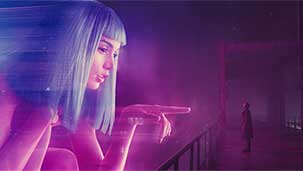It’s possible to be too good at your job. In the case of Blade Runner 2049 the dystopic grandeur each frame of the film reveals threatens to overwhelm a simple, but powerful, story. On the first viewing, anyway.
Director Denis Villeneuve has smuggled an intimate meditation about a universal desire for family connections, and the cost of the entirely contrived tribal distinctions we all perpetuate, into a vast and complex near future landscape.
That landscape, and its inhabitants, are so precisely and powerfully rendered that it easy to lose the story to a kind of awestruck reverence. Your camera tends to linger on vistas filled with monolithic architecture of desolate beauty. These structures loom up out of the perpetual rain like Lovecraftian ziggurats and this aesthetic undergirds much of the tension between the straightforward narrative and how each individual—no matter how seemingly consequential—is a speck of dust at this scale. It would be almost be distracting if it wasn’t so perfect.
The first Blade Runner was a film whose big themes correlated strongly with it’s visual ambitions. Questions like: what is it to be human? And is that a category that is open to interpretation? Blade Runner 2049—while these questions do echo in the background—is centrally concerned with something else.
Ryan Gosling’s K, a new version replicant, is a creature adrift. Like the humans he’s a perfect simulacrum of, once his work is done all he seeks is the same connections his womb born colleagues crave: friends, family, lovers, and a sense of his place in the world. How those basic and universal desires play out, and are realized or denied, is the core of the film.
In the contrast between your masterful depiction of an endlessly sprawling L.A. (with a brief cameo by a dirty-bombed and almost vacant Las Vegas) and the small scale ambitions of the story lies a particular danger. As in the film itself, it is easy to lose track of the little people in these monuments to human failure.
The first time I experienced this film (and that is what it was, an experience—I can’t imagine describing it any other way) I left the theatre wrung dry. But it wasn’t the exhaustion of one too many roller coaster rides. It was the same feeling you get when you first hear a profound piece of music, or finish a book you know has altered the way you see the world—and, more and more these days, anything you put your hand to.
With Blade Runner 2049 there was so much visual information to unpack, and it was so compellingly presented, that I was often pushed as far back in my seat as was possible. As if those few centimetres would allow me to somehow comprehend the scope and decaying beauty of the world unfolding in front of me.
I missed some important character moments in my revery: pivotal pieces of dialogue, small gestures and quiet moments that were nonetheless essential. Given how mesmerizing your compositions are, it’s far too easy to miss the forest for the trees.
Often, when someone says “watch it again” my first thought is “why should I?” After all, if the filmmaker didn’t manage to make clear his intentions the first time around, why should I spend another two plus hours trying to puzzle them out?
Blade Runner 2049 is an exception. Everything was there, plain as day, the first time through. I simply lacked the processing capacity to take it all in. And if there is one thing I love in any work of creative expression, it is the feeling of being over matched—to know the first time through is just the beginning of a beautiful relationship.
Sincerely,

Tim







